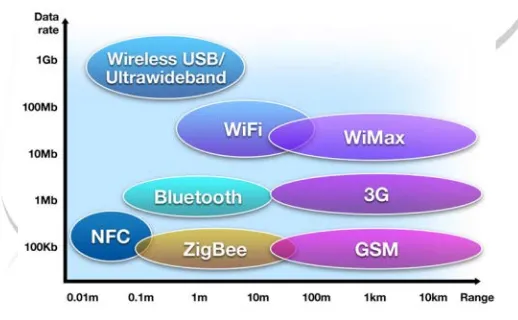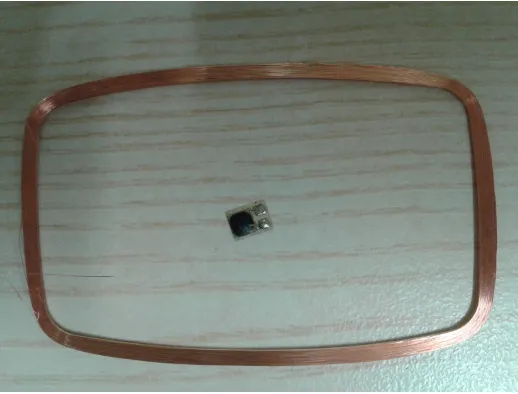IJEDR1503119
International Journal of Engineering Development and Research (www.ijedr.org)1
Near Field Communication
Overview and Applications
Devharsh Trivedi M.Tech. Student,
Computer Science and Engineering (Information and Network Security), Nirma University, Ahmedabad, India
________________________________________________________________________________________________________
Abstract - Near Field Communication (NFC) is a special category or a case of RFID (Radio Frequency Identification)
Technology. The modern age NFC was introduced in 2004 and since 2014 after 10 years of invention it has picked popularity mainly because of cheap hardware, extensive use of smart phones and boom in Internet of Things technology. I have explained in this report about NFC and the implementation that I have done and at last some future work that can be done to extend the use of my application.
Index Terms – NFC, RFID, Android.
________________________________________________________________________________________________________
I.INTRODUCTION
NFC
Near Field Communication (NFC) as its name suggests is a shorter range subset of RFID (Radio Frequency Identification) technology. It has gained popularity as the rising development in today’s technical world. What this wireless communication technology offers is a low bandwidth with high frequency allowing data transfer in range of centimeters.
13.56 MHz is the frequency where NFC operates. It can provide speed up to 424 kbps. NFC tags communication and data exchanges are based on standards like ISO 14443 A, MIFARE and FeliCa. It provides high comfort level and ease of use as there are no further configuration steps required to initiate a session to share data. [1]
Figure 1. Comparison of various wireless standards
Reading from NFC tags is very easy as you just need to bring NFC tag closer to NFC reader and it will start reading from it without providing any connection details. Concept of inductive coupling is used in this architecture. It is also compatible with Bluetooth and Wi-Fi.
RFID
IJEDR1503119
International Journal of Engineering Development and Research (www.ijedr.org)2
Figure 2. Classification of RFID frequency bandRFID can be scanned from a distance of 100 meters without being in line of sight and that’s why it is being used everywhere for asset tracking such as in a warehouse or airport and wild animal movement tracker or livestock identification. As shown in the figure RFID is categorized in various frequency ranges from 120 kHz to 10 GHz spectrum.
NFC works at High Frequency RFID band that is 13.56 MHz the reason why this spectrum is accepted globally is because it is unlicensed and hence anyone can use it freely for transmitting and intercepting data.
NFC vs. RFID
IJEDR1503119
International Journal of Engineering Development and Research (www.ijedr.org)3
Figure 3. Comparison of NFC, RFID, Infrared and BluetoothNFC Forum
It was launched in 2004 by leading companies in the field of semiconductors, communication and electronics as a non-profit organization. The forum educates market about NFC and promotes its usage. They build specifications, standards and maintain interoperability between devices and services. They have around 200 global partner companies who are working towards modular NFC device architecture and much more.
The NFC Forum's Sponsor members are: Intel, NXP Semiconductors, Qualcomm, Samsung, MasterCard Worldwide, NEC, Sony Corporation, Broadcom Corporation, Google Inc., STMicroelectronics, and Visa Inc.
IJEDR1503119
International Journal of Engineering Development and Research (www.ijedr.org)4
II.NFCOPERATING CHARACTERISTICS
As discussed earlier being a wireless communication technology it operates on short-range radio frequency. It is capable to form a peer-to-peer network for data communication. 13.56 MHz band is unlicensed in all the countries.
The technology works when NFC enabled devices brought within close proximity i.e. a small distance around 4 to 20 cm. It can provide transfer data rate of up to 424 Kbps. It also allows data transfer in the chunks of 106 Kbps and 212 Kbps. It can provide a bandwidth of approximately 2 MHz [2].
Figure 5. RF signal coding and data rates in NFC
III.NFCSTANDARDS
ISO (18092), ECMA (340) and ETSI are popular NFC standards. It supports smart cards like Mifare and Felica. NFC has two standards: NFCIP-1 and NFCIP-2. NFCIP-1 is defined in the ECMA-340 standard. This mode is intended for peer-to-peer data communication between devices which is divided into two variants: active and passive mode.
NFCIP-2 is specified in ECMA-352 which defines how to automatically select the correct operation mode when starting communications [3].
Modes of Operations
Active Mode
NFC device operating in active mode generates its own carrier frequency, resulting its own RF field for transmission purpose. It is equipped with a power supply for operation. Active NFC device act as an initiator in communication. Two active NFC devices can alternatively generate RF field to form a two-way communication link to transfer data. NFC device operating in passive mode would not be able to generate its own carrier frequency.
Passive Mode
Passive device acts as a target. Initiator device produces RF field for communication and Target device use inductive coupling for responding them back. Target device modulates to initiator's RF field, for replying back to initiator. Target device uses power from initiator's generated RF electromagnetic field and saves energy. Resultant, Passive device can be provided a small battery for its operation to restrict energy sources consumption.
Modes of Communications
Peer-to-peer
Peer-to-Peer mode is defined for device to device link-level communication. This mode is not supported by the Contactless Communication API. Peer-to-peer mode is a simple or classic mode of NFC operation. It allows data transfer at a rate of up to 424Kbps. It works on NFCIP-1 protocol, whose protocol's detail and electromagnetic properties are standardized in ISO 18092 and ECMA 320/340.
Reader-writer
Read/Write mode allows applications for the transmission of NFC Forum-defined messages. This mode is not secure and supported by the Contactless Communication API. NFC device can also operate as Reader/Writer for tags and smart cards. In Reader/Writer mode, NFC active device act as an initiator and passive tag act as target. This mode allows data transfer rate of 106 Kbps.
Card emulation
IJEDR1503119
International Journal of Engineering Development and Research (www.ijedr.org)5
IV.NFCAPPLICATIONS
Now-a-days most of the high range smart phone provides NFC chips. This has created an unprecedented interest for application developers to take advantage of it and make it useful in many domains. Some of the most popular ones are ecommerce and security. Peer to peer transfer has also found its usages. Some of the applications are as listed below:
• Mobile Payments (m-payments) • Credit Cards Replacement • Advertising
• Educational purpose • Electronic Ticketing • Visiting Cards • Parking Lots • Key less Entry • Device Pairing
eShakti cards in Bihar
Figure 6. Smartcards in Bihar
Janmarg (BRTS) cards in Ahmedabad
Figure 7. Janmarg Travel Card
Security Applications
In cases where authentication is needed for physical access such as starting a vehicle or to enter a room or turn on a machine it can be useful.
Google Wallet
IJEDR1503119
International Journal of Engineering Development and Research (www.ijedr.org)6
4. The terminal might ash or beep to show your payment was made.V.IMPLEMENTATION
I made an android application using Xamarin framework which converts C# code to native APIs. This application can read and write from NFC tags. Though there are many applications available on play store to read and write data but they are not open source. I made another lightweight apk file which simply checks whether the phone has NFC hardware or not which was made in eclipse and that is coded in Java.
The idea was to read and write tag and then process that read data to perform some operation like opening the door, turning on any appliance or just manipulating data with web service.
I have also made use of android apps available on play store to read and write data to NFC tags which supports variety of tags from different manufacturers and can write variety of data to perform many different applications. Following section represents the screenshots of those applications.
IJEDR1503119
International Journal of Engineering Development and Research (www.ijedr.org)9
Figure 10. Application to check whether NFC is supportedFigure 11. Triggers application is used here to write three actions:
1) Display text “devharsh”
2) Enable Bluetooth
IJEDR1503119
International Journal of Engineering Development and Research (www.ijedr.org)10
Figure 12. ‘Triggers’ application to launch actions by reading tagsIJEDR1503119
International Journal of Engineering Development and Research (www.ijedr.org)11
Figure 14. Application designed by me to read and display data from tagsVI.SECURITY THREATS AND SOLUTIONS
Eavesdropping
It is a wireless communication interface so eavesdropping is a big issue. A secure channel must be established. Diffie-Hellman can be used for key exchange to generate a symmetric key which further can be used with AES or 3DES encryption. [4]
Data corruption
Instead of eavesdropping an attacker may disturb the transmitted data. This can be detected by checking RF field as the power needed for corrupting data is higher than detected by NFC.
Data modification
It is different from data corruption as in this case attacker wants receiver to get the malicious data. It can be prevented by regularly checking RF field by active sending device or a secure channel should be used.
Data insertion
Attacker sends his own data along with the data transmitted by both parties. The best solution is to minimize the delay. The attacker cannot be faster than the active device in this case. A secure channel can also be used as remedy.
Man-in-the-middle attack
Attacker can easily implement this attack by generating his own electromagnetic field to induce the receiver. Practically this attack is not possible but it is good habit by sender to listen to RF field before sending data to check for any disturbance present in the channel.
VII.CONCLUSION
NFC is a short range version of RFID which makes it immune to few attacks by default. It is highly interoperable with existing technologies and cheaper hardware has made its use more popular. Many applications are being used for payment and physical access. NFC does not provide protection against threats itself so encryption should always be used.
VIII.ACKNOWLEDGMENT
IJEDR1503119
International Journal of Engineering Development and Research (www.ijedr.org)12
REFERENCES
[1] V. SHARMA, P. GUSAIN, and P. KUMAR, “Near field communication," 2013.
[2] R. Nagashree, V. Rao, and N. Aswini, “Near field communication," International Journal of Wireless and Microwave Technologies (IJWMT), vol. 4, no. 2, p. 20, 2014.
[3] K. Curran, A. Millar, and C. Mc Garvey, "Near field communication," International Journal of Electrical and Computer Engineering (IJECE), vol. 2, no. 3, pp. 371-382, 2012.









